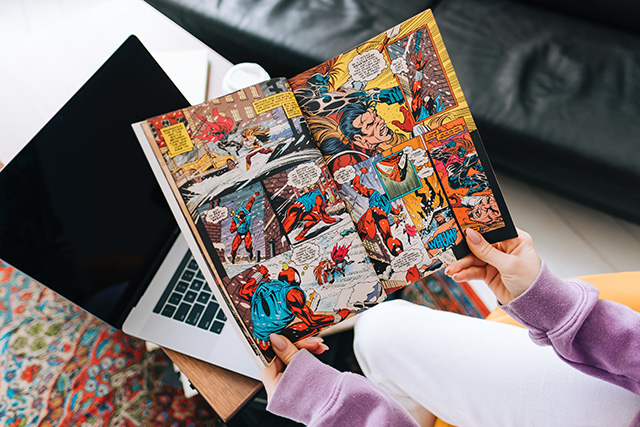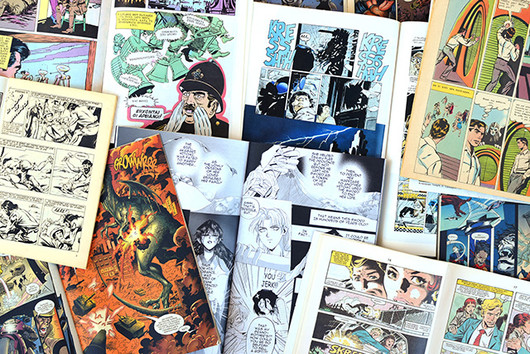What is the Standard Font Size for Comics?
May 23, 2022
Traditionally, comic books have used handwritten fonts created by an individual comic book artist. According to the project’s theme, these professional scripters offer specialized comic lettering styles. They consider speech bubbles’ design, placement, and angle to deliver the right impact on delivery and readability.
Modern comic book fonts come in various styles, including digital and handwritten varieties. Font size is an important technical aspect of comic book creation. It influences how an audience reads and interprets the text and occupies valuable space on the page.
If you’re working on a comic book series, you must choose the letter size for your project. Fortunately, there are several ways to master the art of comic book lettering in terms of font selection and sizing. Explore the basics of comic fonts, point size, text boxes, dialog balloons, and text blocks to help you choose the right font and size for your comic or graphic novel.
Importance of Font Selection
Unless you aspire to the creative level of master comic book letterer Todd Klein, you’ll likely use Google fonts, digital lettering, or another preset lettering style for your design project. Before deciding on the font size, selecting the appropriate font is essential.
Most fonts have different sizes and shapes, so selecting a numerical size will not help with consistency on the page. You must find a suitable font style first, then explore the sizing.
Most comics use an all-caps font—uppercase letters aid in keeping the layout and structure of the page uniform. If you use standard, clean fonts, like Calibri or Times New Roman, in your comic book art, use uppercase letters to make the text easier to read. This lettering also allows you to stagger text within the dialog balloon, giving the page more balance.
Using lowercase letters can disrupt the spacing. For example, a lowercase Y or P can take up space below the line of text, unbalancing the entire block. Although your comic font should be a stylistic choice, it’s also essential to consider the page balance and spacing.
Choosing the Right Comic Fonts
There is a wide variety of fonts for comic books, from traditional bold italic lettering to unique calligraphy fonts. If you are on a budget, you can find hundreds of fonts online for free that align with your book’s distinctive style. If you’re struggling to find what you need from free resources, you can purchase programs like Bundle Font Explorer to explore more options.
Regardless of the type of font you choose, check the licensing terms. You may need to apply for a publication license before using particular fonts for commercial projects, like comic books.
Comic Sans was one of the main styles used for graphic novels and comic book style projects in the past; however, it is no longer a popular choice for modern comics. You should opt for a more modern typeface for a skillful-looking comic, like the Adam Warren Pro, Komika, or VTC letterer fonts.

Letter Size Guid
Since lettering size differs depending on the font, there is no standard comic book lettering size. The Times New Roman 10 has different dimensions than the Arial 10. When deciding on the sizing for your comic lettering, consider the following three critical factors:
Point size
Point size is the unit of measurement used for printed lettering, numbers, or characters on a comic book page. It refers to the height of the individual letter. A 12-point font usually measures ⅙” on a page when printed.
For full-size comic books (6.625” x 10.187” trim), most creators use a 9.5 or 10-point size. For heavier text, you may need to reduce the font size significantly.
Pick the correct point size for your lettering to ensure your reader stays engaged with the story. Confusing letters in jarring fonts can make the reader lose interest or not follow your story. Test out multiple sizes and take print samples before choosing a point and lead size.
Crossbar
The crossbar I rule makes a significant impact on the final product. Since comic book text is written in uppercase, the use of the letter I with the crossbars across the top and bottom takes up a lot of space, particularly in the middle of a word.
Many comic artists only use the crossbar I for the personal pronoun I. They opt for a sans serif capital I for all other instances. Following this unofficial rule can improve the look and readability of your comic book.
Text boxes and dialog balloon
Using text and dialog boxes to create the layout for your page can also help with font size selection. Text boxes are rectangular-shaped, making them easy to design and fill. However, dialog and thought balloons are round and can take up more space.
As a comic artist, your job is to make these balloons attractive and easy to read. Use an imaginary diamond shape when creating balloons. This approach gives them visual structure and allows you to put the lengthiest words in the center and create free-flowing dialog.
Develop Your Dream Comic Book With Comix Well Spring
Mastering all aspects of comic book creation is a lifelong pursuit. In particular, the invisible art of lettering and sizing takes time, trial and error. However, knowing what to look for when choosing your font style and size can help expedite the learning process.
At Comix Well Spring, we understand the challenges of conceiving, designing, and creating a comic book or graphic novel. We offer several professional printing services to help make the process as easy as possible. We can bring your comic and graphic novel designs to life using state-of-the-art printing equipment and quality materials.
We print a range of marketing materials to help promote your comics, from flyers to business cards. Our comprehensive services also include a digital selling platform, where you can advertise and distribute your creations.
If you need more information on our printing services, browse our website or call us at (734) 927-0044.

